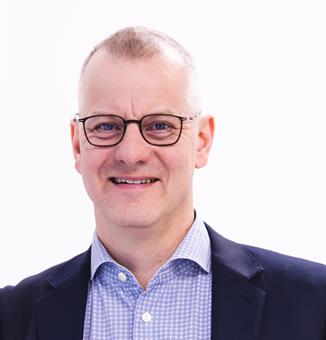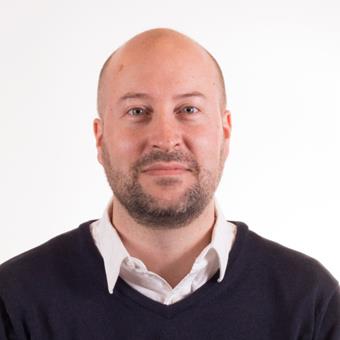Alzheimer research is striding ahead in Linköping. When the Swedish Brain Foundation recently awarded grants for Alzheimer research, Per Hammarström and Martin Hallbeck received two of the six research grants. Photo credit Emma Busk WinquistMartin Hallbeck, associate professor in the Department of Clinical and Experimental Medicine, compares collaboration between researchers with different expertise to examining an extremely large picture.
“You can look at the whole picture from a distance, or maybe you are particularly interested in a particular component, the flowers for example, and get really close to examine them in detail. We see different things, and can gain a more complete image when we help each other and benefit from each other’s knowledge.”
Martin stands with one foot in the research camp, and the other in medical care, as senior consultant in anatomical pathology. His research focusses on how Alzheimer’s disease spreads to new parts of the brain, and ways to brake the spread. In Alzheimer’s disease, misfolded proteins form aggregates in the brain and become so toxic that the nerve cells eventually die. In other words, proteins are central part of the puzzle. This is why Per Hammarström, professor in protein chemistry, is interested in diseases of the brain that are caused by the misfolding of proteins. He has studied the misfolded proteins in Alzheimer disease for many years, and shown that they do not take up a single form, but many.Amyloid plaque in a brain blood vessel in a mouse. It has been dyed with molecules developed by researchers at LiU. Different colours represent different amyloid forms. Photo credit Sofie Nyström
“As a chemist, I am interested in how differences in the molecular structure of proteins cause clinical differences between patients”, says Per Hammarström, professor in the Department of Physics, Chemistry and Biology.
Both researchers have targeted their research onto contributing to new treatments and better diagnosis for people affected by diseases in which the nervous system is slowly degraded. They are convinced that researchers from different fields must collaborate to achieve this. The brain is a particularly challenging organ for research. It is extremely complicated, difficult to access, and one of our most important, and sensitive, organs.
“It’s extremely difficult to conduct research that covers the full range from molecules to how cells and organs function, and finally to effective treatments for patients. In order to solve that puzzle, we need many different types of knowledge”, says Martin Hallbeck.
Per Hammarström agrees: “In order for knowledge from one link in the chain to be transferred to the next link, the chain of expertise must be intact. This makes it much easier for us to go back and change something if, for example, it becomes clear that a promising molecule does not enter the correct cells in the brain.”
Keys to a fruitful cooperation
So what is needed to establish productive collaboration? Closeness, which makes it easier to meet spontaneously over coffee or in the corridor, where it is easy to exchange ideas with each other. Another important component is that everyone involved in a collaboration is interested in the question they are working on, and that researchers do not compete in a negative manner.There is a lot of ongoing research on the brain at LiU. Photo credit PhonlamaiPhoto
“It’s also important that people get to know each other. This makes it easier to trust each other without hesitation. It’s not just about doing research together. It’s at least as important to create a healthy research environment and encourage each other. The initiative in systems neurobiology has given a boost to this complete field of research in Linköping”, says Martin Hallbeck.
The Center for Systems Neurobiology is a common strategic investment from LiU and Region Östergötland, in which research groups from both the Faculty of Medicine and Health Sciences and the Faculty of Science and Engineering are involved. It offers technology platforms that individual research groups would otherwise have difficulty to access.
“Huge research groups are not the tradition in Sweden. Instead, we set up collaborations and meet each other over technology platforms. I believe that this opens the opportunity to test new ideas. In addition, it’s easier for LiU to recruit new people with attractive expertise, and to retain its current personnel, when there is not only a critical mass of scientists working in the field but also an interesting research environment”, says Per Hammarström.
One thing they both would like to see is the expertise gathered under one roof.
“It’s our dream to create a centre for research into neurodegenerative diseases, and thus benefit even more from the talented scientists at LiU. I believe that we have a great potential to make important breakthroughs that can benefit patients in the future”, says Martin Hallbeck.
Translated by George Farrants
The article has also been published in LiU Magasin (in Swedish) 3/19



